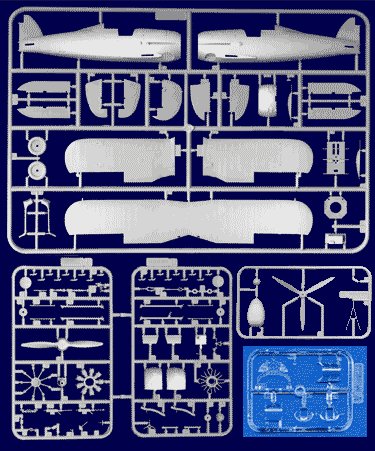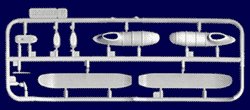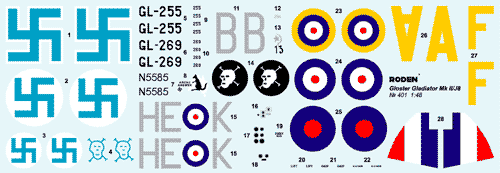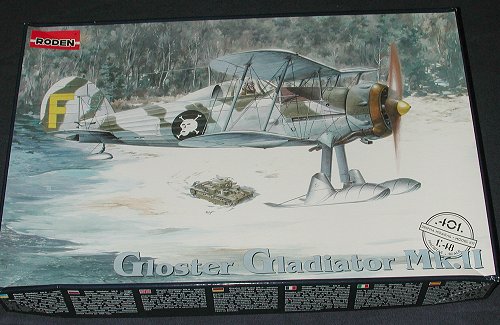In 1937 the Royal Air Force's last biplane fighter the Gloster
Gladiator did not satisfy the demands of modern air combat - the future
belonged to high-speed monoplanes, and the war that approached Europe
would become a war of 'next generation' technology.
However, the interests of the British Empire meant a military presence in
the most remote parts of the world, including South Africa and the Middle
East. That is why the Ministry of Aviation placed an order with the
Gloster Aircraft Company for the improved Gloster Gladiator Mk.II
modified according to the requirements of specification F.36/37. The most
significant innovation was the substitution of the Bristol Mercury IX
engine with the Mercury VIIIA: the capacity was still the same, but the
gear ratio was 0.572, permitting the installation of the new three-blade
Fairey Reed metal airscrew. There were no more external differences, but
the designers also paid attention to improving the business of flying the
aircraft. The Mk II had an electric engine starter, an improved
navigation system, and new equipment for measuring altitude and climb
rate. Since the intended operating area was the desert, the aircraft was
equipped with a tropical carburetor intake, as well as a special
container with water and provisions.
In 1938, just before the Munich Crisis, the Gladiator Mk. II served in
the front line of the Royal Air Force. However, after the arrival of the
Hawker Hurricane in sufficient quantities, they were gradually
transferred to the Auxiliary Air Force. The Gladiator Mk.II was too
obsolete for modern air combat, but the shortage of new types led to
extensive service during the first years of the war.
Right after the beginning of WWII, Gladiator Mk. IIs were sent to France
as part of the Expeditionary Force. Sadly, their career was very short -
after one Luftwaffe raid almost all machines were destroyed.
At the time of the Battle of Britain, 247 Squadron of the Royal Air Force
was the only unit equipped with the Gladiator Mk.II; pilots flying the
type managed to score several victories. The most notable campaigns in
which the Gladiator Mk.II took part were the Battle for Norway and the
South-African Campaign. Numerous victories over enemy planes proved that
when piloted by an experienced pilot, the Mk.II could be a deadly weapon.
Another important part of the Gladiator Mk.II's fighting career was the
Winter War between Finland and the Soviet Union. The Swedish volunteer
squadron that arrived in Finland with their own Gladiators (the Swedish
export version of the Gladiator was known as the J8) fought on the
Finnish side along with the pilots of the Finnish Air Force. The Swedes
managed to shoot down at least 10 Soviet planes. The most successful
Finnish ace Oiva Tuominenn scored 4 victories flying the Gladiator Mk.II.
To secure take-off and landing in snowy regions most Finnish and Swedish
fighters were equipped with skis.
The Finnish Gladiator Mk.II fought on the front line the longest, until
the middle of 1943. In North Africa the Gladiator Mk.II served until the
end of 1942. Other Mk.IIs were used as messenger and weather
reconnaissance planes until 1944.
Thanks to
Roden for the historical background.
I
This is the third
boxing of the Roden Gladiator and it continues to be probably the best
1/48 Gladiator on the market. As you all know, I tend to look over new
kits to see what, if any, molding glitches I can find. Some chastise me
for be obsessive about it, but to be honest, these things cause me
additional work to repair/remove so I like it when I can't find any! This
kit is pretty well free from flash and while there are ejector pin marks
on the inside of large parts like the fuselage and cowling, the rest of
the kit is, as far as I can see, free from them. I did find a few sink
areas on the rear fuselage, which just happen to be opposite some rather
large ejector towers!
 As is the norm for Roden
and others, this kit includes all the bits and pieces to do any of the
Gladiators as long as you know the differences and have some aftermarket
decals. You get both the two and three bladed prop as well as the
arrestor hook and other naval equipment. In addition, this boxing
provides skis on a smaller sprue (shown to left). I had always thought
that the skis were only as long as the 'boots', but apparently I'm wrong
about that and they are actually longer.
As is the norm for Roden
and others, this kit includes all the bits and pieces to do any of the
Gladiators as long as you know the differences and have some aftermarket
decals. You get both the two and three bladed prop as well as the
arrestor hook and other naval equipment. In addition, this boxing
provides skis on a smaller sprue (shown to left). I had always thought
that the skis were only as long as the 'boots', but apparently I'm wrong
about that and they are actually longer.
Kit instructions are
really excellent, providing all the needed differences between the
various markings options. Color information is provided as generic names
and Humbrol equivalents and any colors needed during the various
construction steps are provided. As with nearly all biplanes, rigging is
required and a full rigging diagram is provided so that we can get that
part of it right.
Decals are crisply
printed and quite matte. Markings are provided for no less than seven
aircraft, though some are quite similar in markings. You get a choice of
two British and five Finnish/Swedish aircraft.
 Gloster Gladiator Mk.II,
B/N5585, No.247 Sqn RAF, Roborough, August 1940, flown by PO N.I.C.
Francis.
Gloster Gladiator Mk.II,
B/N5585, No.247 Sqn RAF, Roborough, August 1940, flown by PO N.I.C.
Francis. - Gloster Gladiator Mk.II, HE-K/serial unknown, No.263 Sqn RAF,
Battle of Norway, Spring 1940.
- Gloster Gladiator Mk.II, GL-255 of LLv 26, Finnish Air Force,
Winter War, Finland, Mensunkangas, flown by Sgt Oiva Tuominen (44
victories in total, 6 ? on Gladiator), February 1940.
- Gloster Gladiator Mk.II, GL-269 of 1/LLv 26, Finnish Air Force,
Winter War, Finland, Utti, flown by Capt Paavo Berg (5 victories),
February 1940.
- Gloster Gladiator J-8A, "yellow A"/271 of Flygflottilj F 19 (Royal
Swedish Air Force), Winter War, Finland,pilot unknown, winter 1940.
- Gloster Gladiator J-8A, "yellow F"/284 of Flygflottilj F 19 (Royal
Swedish Air Force), Winter War, Finland, Lake Kemi, flown by 2Lt F H I
Iacobi, January 1940 (two marking options, one without insignia and
with the death's head on the fuselage).
For those who don't like any of the choices, there are some
aftermarket decals for the Gladiator available.
Yet another super kit from Ukraine's top model
maker. I would bet that this will be the last boxing you'll see as I
can't think of any other variants of the Gladiator. If you want the most
choices and are planning to use aftermarket decals, then this is the
boxing to get.
If you would like your product reviewed fairly and quickly by a
site that has over 200,000 visitors a month, please contact
me or see other details in the Note to
Contributors.



 As is the norm for Roden
and others, this kit includes all the bits and pieces to do any of the
Gladiators as long as you know the differences and have some aftermarket
decals. You get both the two and three bladed prop as well as the
arrestor hook and other naval equipment. In addition, this boxing
provides skis on a smaller sprue (shown to left). I had always thought
that the skis were only as long as the 'boots', but apparently I'm wrong
about that and they are actually longer.
As is the norm for Roden
and others, this kit includes all the bits and pieces to do any of the
Gladiators as long as you know the differences and have some aftermarket
decals. You get both the two and three bladed prop as well as the
arrestor hook and other naval equipment. In addition, this boxing
provides skis on a smaller sprue (shown to left). I had always thought
that the skis were only as long as the 'boots', but apparently I'm wrong
about that and they are actually longer. Gloster Gladiator Mk.II,
B/N5585, No.247 Sqn RAF, Roborough, August 1940, flown by PO N.I.C.
Francis.
Gloster Gladiator Mk.II,
B/N5585, No.247 Sqn RAF, Roborough, August 1940, flown by PO N.I.C.
Francis. 